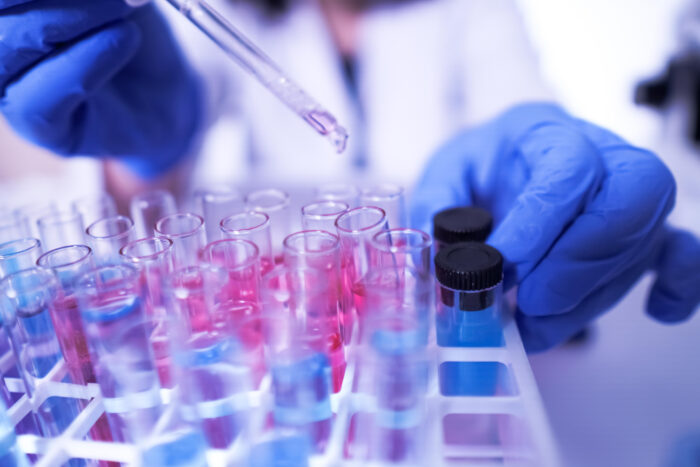
Twenty years after researchers published their first discoveries associated with human genome sequencing, policymakers are fighting to overcome obstacles that hobble the potential of genetic medicine to recognize, diagnose and cure rare diseases.
While Covid has made living with rare disease harder than ever, it has also broken down some previously intractable cultural norms in the life sciences. Advocates hope those changes stick so they can find long-overdue cures.
“It’s time to change the narrative: rare disease is a public health issue because while individually, these diseases are rare, collectively, they are common,” said Dr. Christopher P. Austin, director of NIH’s National Center for Advancing Translational Sciences, at a recent virtual NIH conference. “The lives of rare disease patients are every bit as important as the lives of Covid patients. If we move heaven and earth to diagnose and treat Covid patients, we need to do this for rare disease patients, too.”
The conference organized by the National Institutes of Health (NIH) last week to commemorate Rare Disease Day highlighted the strides made during, and in spite of, the challenging year that 2020 represented, and galvanized a broad cross-section of supporters to fight for cures.
The Food and Drug Administration, Broad Institute and hundreds of institutions across the globe held their own Rare Disease Day events over the course of the week. Celebrated on the last day of February each year, this event seeks to raise awareness of the roughly 7,000 rare diseases we know about while improving treatment access and ensuring medical representation for people with rare diseases and their families, who still fight for recognition.
Although these diseases are called “rare,” according to the NIH there are at least 30 million people in the US living with one, and they affect roughly 8% of the world’s population.
While advances in fundamental science have been “unprecedented,” Austin shared the grim statistic that under 5% of known rare diseases have FDA-approved treatments. This week, Austin pushed for translational science to catch up because “rare diseases don’t wait.”
The Power of Patient Advocacy
It took concerted advocacy by families, diagnostic companies and drug developers to get the NIH here. Arguing that the government’s current data sharing policies do not align with FAIR principles — which require data to be findable, accessible, interoperable and reusable — these groups have successfully pushed the agency to make sweeping changes to its data-sharing practices in order to translate government science into actual cures, while building their own data-sharing hub with FDA funding.
Traditionally, government-funded researchers have been able to hold onto their genomic data very tightly, arguably to protect patients’ phenotype (personal) data. However, these protections left translational medicine researchers unable to move forward with solving the medical problems these NIH-funded researchers discovered.
In response to years of demands from industry and patients, the agency started off by developing the Strategic Plan for Data Science, a roadmap for modernizing the NIH-funded biomedical data science ecosystem. Over five years, it took input from researchers, institutions, data providers and users, research participants, infrastructure developers, Tribal Nations, and patient advocates to create new guiding policies and procedures.
As the next major step on the roadmap, starting in January 2023, the agency will adopt its Final NIH Policy for Data Management and Sharing, updating the previous policy, requiring all NIH grant applicants to put a Data Management and Sharing (DMS) Plan into their grant proposals and underlining an “expectation that researchers will maximize appropriate data sharing when developing sharing plans.” Notably, this policy allows for researchers to allocate part of their budgets toward data curation, storage and sharing through data repositories, such as the Rare Disease Cures Accelerator-Data and Analytics Platform (RDCA-DAP).
Built by the National Organization for Rare Disorders (NORD) and Critical Path Institute (C-Path), the RDCA-DAP provides a centralized and standardized infrastructure to support and accelerate rare disease characterization, with the goal of accelerating therapy development across rare diseases.
Some patient advocates are opting not to wait for NIH to open its data, however. Self-titled “rare disease crusaders” are partnering with start-up company Ciitizen to launch their own natural history studies and give translational medicine companies access to their data, on their own terms. Founder Anil Sethi left his job as Apple’s Director of Health Records to build the tool after his younger sister Tania died of metastatic breast cancer. Now, rare disease advocates like the parent-led BPAN Warriors are working with Ciitizen to propel research into less-understood diseases like Beta-propeller Protein-Associated Neurodegeneration (BPAN), which is caused by mutations in the gene WDR45, located on the X chromosome. Individuals with the BPAN mutation are developmentally delayed during childhood, experiencing clumsiness, trouble walking, seizures and generalized cerebral atrophy. During adolescence or adulthood, affected individuals experience a relatively sudden onset of progressive dystonia-parkinsonism and cognitive decline.
“A single lab report or a single test result only tells part of a story,” Sarah Chisholm, Founder of BPAN Warriors, said in a press release about the study’s launch. “Ciitizen provides us with the ability to rapidly assimilate and analyze 1000’s of points of data, across a large cohort of BPAN patients.”
Overcoming Traditional Hurdles Through Partnership
Meanwhile, collaborators are piloting creative solutions to longstanding challenges, propelled by the success of recent novel research initiatives to battle Covid, Alzheimer’s, diabetes and cancer.
NIH Director Dr. Francis Collins told NIH Rare Disease Day attendees last week that the key to curing rare disease was “putting partnerships into practice,” using the example of a “bespoke gene therapy consortium” model developed by Peter Marks, director of the Center for Biologics Evaluation and Research (CBER) at the Food and Drug Administration. Under this design, public and private organizations could collaborate under a nonprofit umbrella to develop “plug-and-play” technologies that could be widely applied across diseases.
“By working together, sharing knowledge, and collaborating, we can achieve faster diagnosis and better treatments for rare diseases,” Dr. Anne Pariser, director of NIH’s National Center for Advancing Translational Sciences, told conference attendees. Pariser oversees the Rare Diseases Clinical Research Network (RDCRN), a collaborative among 20 teams of researchers, patients and clinicians, each focused on a group of rare diseases.
Covid’s Impact on Rare Disease Patients
Dr. Marc E. Rothenberg and Dr. Thomas W. Ferkol presented the RDCRN’s preliminary findings on the impact of Covid on rare disease patients at the NIH conference, noting that while only 71 of the 3,400 respondents were diagnosed with Covid over the study period, significant numbers of rare disease patients exhibited symptoms, implying underdiagnosis in the rare disease community.
According to the report, the pandemic “negatively affected rare disease patients in terms of access to regular health care, treatment for the rare disease, special diet, and special treatment and hospitalization, even among those who reported acquiring the infection.”
This aligns with previous findings.
As the National Organization for Rare Disorders (NORD) reported last May, patients with rare diseases and their families were profoundly impacted during the Covid-19 pandemic.
With 95% of respondents to the nationwide survey reporting the pandemic had taken a toll on “their immediate and long-term health and well-being,” 74% missed at least one medical appointment due to the pandemic, 40% had lost income and 29% reported loss of a job, with 11% of those job losses resulting in a complete loss of health insurance.
Nearly all — 98% of respondents — were worried about themselves and their loved ones in the pandemic, with concerns ranging from not being able to accompany a non-ambulatory and non-verbal family member to the hospital to being forced to stop needed transfusions or chemotherapy.
Using Tech Innovations Necessitated by Covid to Fight Rare Disease
Caregivers to people with rare disease presented to NIH about the need to continue investing in technology advances in telehealth and remote communications, which they reasoned could open up a world of access to rare disease patients, many of whom are home-bound to begin with.
The three main Covid-related technology uses that rare disease advocates mentioned seeking are: higher-quality communication during virtual visits; open access to digital information, including the removal of paywalls on journal articles; and taking studies virtual to increase access and lower barriers to entry.
A Tufts Center for the Study of Drug Development report from November 2020 supports the trend toward virtual clinical trials, finding that “55% of active ongoing clinical trials have transitioned to remote and virtual execution models since early spring.”
Principal investigator Ken Getz wrote in the report:
“Among other benefits, decentralized trials have provided increased convenience and minimized coronavirus transmission risk for study volunteers, while offering drug developers potentially lower costs and faster access to scientific and operating data.”
While the above benefits are beneficial, what rare disease patients are overwhelmingly looking for is a cure.
“Telemedicine is nice, but my takeaway from Covid and what advocates want is empathy and action,” Christine Waggoner, president and founder of Cure GM1 Foundation, said in a phone interview. “Rare disease patients really want treatments developed quickly and in an affordable manner.”
Waggoner’s foundation has held a key role in both foundational research on this genetic lysosomal storage disorder, developing natural history studies with academic and government partners, and translational medicine, helping recruit for gene therapy clinical trials with biotech companies Passage Bio, Lysogene and Sio Gene Therapies.
Going to the Root With Vector Gene Therapy
Gene therapy is a crucial tool in treating rare diseases, 80% of which are genetic in nature. At the NIH conference last week, Nobel Laureate Jennifer A. Doudna presented the ways we can now use CRISPR in diagnosing and treating rare diseases. With CRISPR technology, she said researchers are going from a “one-disease-at-a-time” strategy to platform-based approaches that allow them to understand many diseases at once.
Advocates say this future can’t come fast enough. Approximately 50% of those diagnosed with a rare disease are children, and 3 in 10 of them will die before the age of 5. Waggoner with Cure GM1 Foundation said her daughter just turned 13 but suffers multiple seizures a day. Few children with GM1 Gangliosidosis make it that far.
True to the International Human Genome Sequencing Consortium’s conclusion in their fateful paper 20 years ago, “the more we learn about the human genome, the more there is to explore.” With open communication, people with rare diseases and their loved ones hope the secrets of the genome will finally be unlocked.










